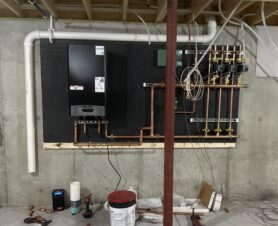I often think of a hydronic systems as a living and breathing thing, like a human body. The hydronic system carries BTUs to the extremities of the building, like a body’s circulatory system, and the circulator pumps are the heart. We have been told that the heart is the strongest muscle in the body, using considerable energy. Without the heart, the body goes “down.” Similarly, pumps use considerable energy, and are vital to the building’s continued operation.

Pumping energy is not the first thing that comes to mind for most when speaking of energy efficiency. However, pumping of the fluid for a hydronic system can be optimized in many different ways, providing impressive savings.
The geothermal industry has been using food safe propylene glycol for years in geothermal and hydronic systems. Water is the basis and standard for the best in fluid viscosity and energy efficiency, but in order to maintain fluid integrity and protect against freezing, glycol is necessary in geothermal and hydronic distribution systems.
Hydronic systems are the most energy efficient way to move BTUs around a building in every situation of which I am aware. Viewing the chart below, you can see that air distribution systems expend up to 45% of their energy just to move energy around the building (fan power).
This is why distributed Geothermal Heat Pump systems are so efficient. Rather than large ducts to pump high volumes of air to different zones, GHPs are placed in the individual zones. Many times, these GHPs can provide radiant heating and cooling, further optimizing the energy consumption for distribution to as low as 20% of the total energy consumption.
In any building with a forced air HVAC system, switching to hydronic distribution can save 25% or more on energy costs. Pumping power is sometimes difficult to quantify. For geothermal ground loops, one directive is that pumping power of about 5 hp per 100 tons tends to be the best efficiency (Modern Geothermal HVAC Engineering and Control ApplicationsISBN-10: 0071792686; ISBN-13: 978-0071792684, p 151). The text from Dr. S.P. Kavanaugh goes on to say that pumping power should not be higher than 10 hp per 100 tons.
There are many situations by which the pumping power can be reduced by good engineering practices. Some of these practices include adequate pipe sizing and good construction practices, including pump, valve, and control selection. For example, rather than direct or reverse return, a system can be designed using decoupled secondary circuits with individual circulators, sometimes reducing the pumping power of a hydronic distribution system by 40% or more.
The pumping power of the single pipe system is lower than that of any other. In a single pipe hydronic system, pumping energy is reduced by design to the lowest extent possible. The more common hydronic system is a reverse return and uses two pipes for distribution. Electrical consumption in a hydronic system can be reduced from 45% to about 20% of total load by applying good hydronic practice.
A water based hydronic system with no additives is proven to have the lowest viscosity and best heat transfer properties. But that’s simply not possible most of the time. Glycol and various chemicals must be added to provide freeze protection and to maintain fluid integrity for protection and longevity of the components in a hydronic system. As the concentration of glycols go up, so does the viscosity and the pumping power requirement
A company has developed an FDA approved non-petroleum glycol that has a fluid viscosity that can save 40% or more on pumping power. In addition, this glycol has a greater capacity to move energy. In the graph below, at 32F (0C), propylene glycol solutions are more than twice the Kinematic Viscosity of their non-petroleum based FDA approved glycol (Kilfrost GEO).
Many authorities having jurisdiction require food safe glycol to be used in hydronic systems. Additionally, geothermal exchangers should be designed to protect the drinking water aquifers into which they are inserted. In some areas, ethylene glycol is considered acceptable, but many allow only FDA approved products.
There is one more part to the energy story. Water alone is the best vehicle for carrying BTU energy. As glycol is added, the “Prandtl Number” goes up, denoting decreased heat transfer efficiency. The Kilfrost GEO product has a better heat transfer efficiency than any other glycol listed for hydronic systems.
Your Customer is Worth It
Unfortunately, there are those contractors that will put in an expensive, high quality piece of equipment and then install the least expensive thermostat possible. We’re not about to do that. I learned a long time ago to offer the best quality available, and then the consumer can make the choice to downgrade if they choose. I’ve found that any consumer with the wisdom to choose a high quality HVAC system will also choose the high-end specialties.
As a case in point, geothermal systems often have a higher up-front cost than air-sourced HVAC systems; primarily because the in-ground heat exchanger is a major portion of the project’s cost. The highest quality pipe and valves are specified for these systems. The fluid running through the pipes should be the best available at any price. When considering glycol for any hydronic system, and especially a geothermal system, here are some considerations to take into account.
Glycol Considerations:
- Fluid Efficiency
- Increase performance and save money
- System Protection
- Ensure reliability and confidence
- Personnel & Environmental Risks
- Protect the aquifers and the environment
- Food safe
- FDA approved ingredients
Knowing what I do about how significant pumping energy can be, I would prefer to have a non-petroleum based glycol that can also reduce pumping energy consumption by 25% or more. I am reasonably certain that any client would make the same decision.
There has never been a better time to get involved in geothermal HVAC systems. Get trained as a designer or installer of geothermal systems. To find out more, visit IGSHPA.org and GEO, our industry organizations. IGSHPA already is training our building inspectors on geothermal heating and cooling systems.
Geothermal; Luxury and Peace of Mind
 Jay Egg is a geothermal consultant, writer, and the owner of EggGeothermal. He has co-authored two textbooks on geothermal HVAC systems published by McGraw-Hill Professional. He can be reached at jayegg.geo@gmail.com.
Jay Egg is a geothermal consultant, writer, and the owner of EggGeothermal. He has co-authored two textbooks on geothermal HVAC systems published by McGraw-Hill Professional. He can be reached at jayegg.geo@gmail.com.
*Modern Geothermal HVAC Engineering and Control ApplicationsISBN-10: 0071792686; ISBN-13: 978-0071792684, p 151 Copyright ©EggGeothermal Consulting and McGraw-Hill Education
** Copyright © Kilfrost ®Group Public Limited Company dated 2015. All rights reserved.
DropBox Folder to Correlating Slides








Join the conversation: